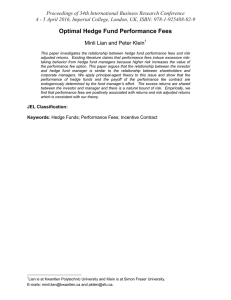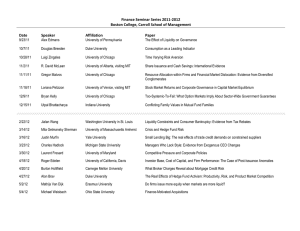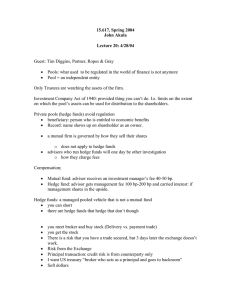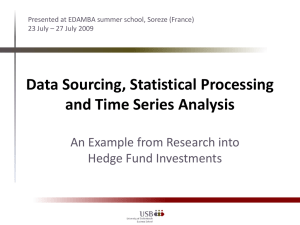Further Evidence on the Role of Ratio Choice Abstract
advertisement
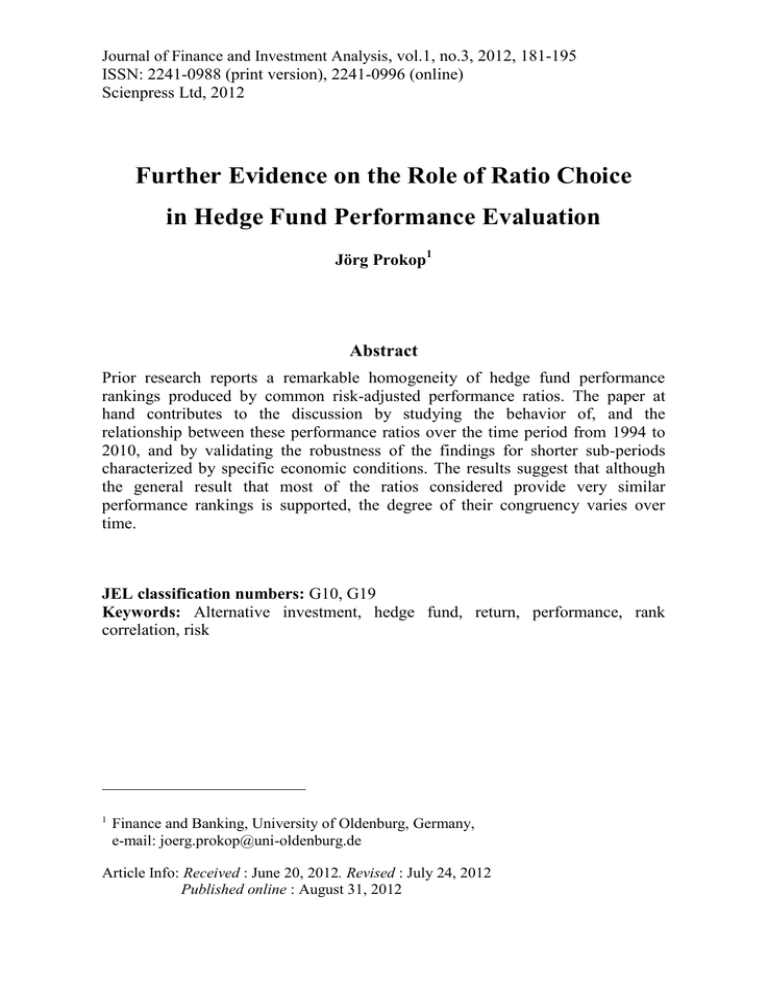
Journal of Finance and Investment Analysis, vol.1, no.3, 2012, 181-195
ISSN: 2241-0988 (print version), 2241-0996 (online)
Scienpress Ltd, 2012
Further Evidence on the Role of Ratio Choice
in Hedge Fund Performance Evaluation
Jörg Prokop1
Abstract
Prior research reports a remarkable homogeneity of hedge fund performance
rankings produced by common risk-adjusted performance ratios. The paper at
hand contributes to the discussion by studying the behavior of, and the
relationship between these performance ratios over the time period from 1994 to
2010, and by validating the robustness of the findings for shorter sub-periods
characterized by specific economic conditions. The results suggest that although
the general result that most of the ratios considered provide very similar
performance rankings is supported, the degree of their congruency varies over
time.
JEL classification numbers: G10, G19
Keywords: Alternative investment, hedge fund, return, performance, rank
correlation, risk
1
Finance and Banking, University of Oldenburg, Germany,
e-mail: joerg.prokop@uni-oldenburg.de
Article Info: Received : June 20, 2012. Revised : July 24, 2012
Published online : August 31, 2012
182
Ratio Choice in Hedge Fund Performance Evaluation
1 Introduction
The purpose of this paper is to study the influence of ratio choice on hedge
fund performance evaluation. Risk-adjusted performance measures typically
employed in portfolio management focus on different aspects of an investment
asset’s return distribution. Some of them treat positive and negative returns in the
same way, some emphasize the upside potential, and some put more weight on
avoiding downside risk. From a conceptual point of view, the measure chosen
should be in line with the specific investor’s investment objectives, and it should
capture the attributes of the asset’s risk-and-return profile that are most important
to him or her. Thus, performance evaluation is an inherently subjective,
investor-specific task.
However, prior research shows that several performance ratios basically lead
to the same ranking of investment opportunities, and thus to the same investment
decision [3, 4, 5]. If this finding proves robust, it is of immediate relevance to
investment practice: Identifying a performance measure – preferably one that can
be determined easily – that may serve as a robust proxy for a larger number of
other ratios could significantly facilitate performance measurement both by
professional and by private investors.
In this context, the paper at hand ties in with findings by Eling and
Schumacher [4, 5] regarding the adequacy of the Sharpe ratio as such a ‘universal’
ratio in hedge fund performance evaluation. In particular, I contribute to the
discussion by studying the behavior of, and the relationship between the respective
performance ratios over a long time horizon, and by validating the robustness of
the results for shorter sub-periods characterized by specific economic conditions –
namely, the boom periods 1994-1999 and 2003-2007, and the crisis periods
2000-2002, and 2008-2010. In this vein, I scrutinize whether there is any
empirical evidence that the latter two events have come along with structural
breaks in the patterns identified by Eling and Schumacher [4, 5].
In line with Eling and Schumacher [4, 5], I show that most of the
performance measures considered lead to similar rankings of the respective
investment indices. In particular, the rank orders based on the Sharpe ratio are
close to those derived from more sophisticated performance ratios. Moreover, I
find that performance rank orders are more homogeneous for the best and for the
worst performing portfolios, and more diverse for the middle-ranking strategies
especially during the period 1994-1999. Therefore, although the general result that
the Sharpe ratio provides remarkably robust performance evaluations is supported,
I conclude that investors are still well advised to exercise due care in choosing a
performance measure that adequately reflects their individual investment
objectives, and risk preferences.
The next section briefly reviews the main studies relevant to this paper’s
topic. Section three specifies the data and the methodology used. Section four
develops the results, and section five concludes.
J. Prokop
183
2 Literature Review
Compared to other finance topics, the analysis of hedge fund performance is
a relatively young area of scholarly research. Nevertheless, since the emergence of
the first academic papers during the mid-1990s, a considerable body of literature
explicitly addressing hedge fund performance measurement issues has evolved.
Most of these studies tie in with Fung and Hsieh [6], who propose a framework for
the analysis of hedge fund investment styles based on a Sharpe [8]-type
multifactor model. Besides, a second main area of hedge fund research is the
analysis of performance persistence [1].
In contrast, the paper at hand concentrates on the influence of ratio choice on
hedge fund performance evaluation. This issue has also been addressed in prior
studies by Eling and Schumacher [4, 5], who provide a detailed discussion of the
robustness of a variety of performance ratios for the time period 1994-2004. They
find that most of the ratios considered produce similar rank orders of hedge fund
index returns [4] and of individual hedge fund returns [5]. In particular, they show
that performance rankings based on the Sharpe ratio do not differ significantly
from those based on more sophisticated downside risk-related ratios, and they
conclude that in spite of potential conceptual concerns, using the Sharpe ratio to
assess hedge fund performance may be justified from a practical point of view. In
a conceptually similar study, Eling [6] also finds a high correlation of performance
measures when applying them to mutual fund returns.
Zakamouline [9] challenges Eling and Schumacher’s [5] approach, mainly
claiming that the majority of the return distributions they analyze is close to
normal, and that the Spearman rank correlation coefficient they base their
conclusions on may be biased. In the following study, I take this critique into
account by showing that the return distributions underlying my study are
non-normal, and by corroborating the results of the Spearman rank correlation
coefficient with two alternative homogeneity measures, the mean absolute and the
mean squared deviation.
3 Data and Methodology
The study is based on monthly return data between January 1994 and
December 2010 for the Dow Jones Credit Suisse Hedge Fund Index (HFI), and for
twelve hedge fund strategy sub-indices belonging to the Dow Jones Credit Suisse
family of hedge fund indexes. The composite index HFI is an asset-weighted
index tracking about 8000 hedge funds, each with a minimum of US$50 million
under management, a 12-month track record, and audited financial statements.
The respective strategy sub-indices contain hedge funds following the investment
strategies outlined in Table 1 (cf. http://www.hedgeindex.com). In addition,
monthly return data for the MSCI World equity index (MSCI), the Standard and
Poor’s 500 (S&P 500) and the US federal funds rate (Fed) are employed.
184
Ratio Choice in Hedge Fund Performance Evaluation
Table 1: Hedge fund strategy definitions
Strategy
Abbreviation
Description
Convertible
Arbitrage
CA
Investment strategies trying to exploit pricing
anomalies between convertible securities and the
corresponding stock.
Dedicated
Short Bias
SB
Investment strategies relying mainly on short positions
in equities.
Emerging
Markets
EM
Investment strategies involving various types of
securities in emerging markets.
Equity Market
Neutral
MN
Investment strategies taking long and short positions in
stocks, while trying to avoid exposure to systematic
risk.
Event Driven
ED
Investment strategies trying to exploit security pricing
anomalies due to certain company-specific or
market-specific events.
Event Driven –
Distressed
EDD
Subset of event-driven strategies focusing on securities
of companies in financial or operational difficulties.
Event Driven –
Multi-Strategy
EDM
Subset of event-driven strategies trying to exploit
various types of event-related security pricing
anomalies.
Event Driven –
Risk Arbitrage
EDA
Subset of event-driven strategies focusing on
companies involved in a merger or acquisition
transaction.
Fixed Income
Arbitrage
FI
Investment strategies trying to exploit pricing
anomalies between similar or related fixed income
instruments.
Global Macro
GM
Investment strategies focusing on the anticipated
effects
of political and macroeconomic developments on
security prices in various markets.
Long/Short
Equity
LS
Investment strategies involving long and short positions
in equity.
Managed
Futures
MF
Investment strategies focusing on financial futures and
commodity futures.
J. Prokop
185
The analysis proceeds as follows: First, I discuss the respective assets’ return
distributions and their correlation structures for the entire observation period, as
well as for four sub-periods representing different stock and fixed income market
environments, as shown in Figure 1. Period I (1/1994-12/1999) is characterized by
a bullish stock market, and relatively stable interest rates. In period II
(1/2000-12/2002), stock prices as well as interest rates decreased considerably.
Period III (1/2003-12/2007) is characterized by a steady increase in stock prices
and interest rates. During the first half of period IV (1/2008-12/2010), stock
markets declined strongly, but recovered afterwards, while interest rates declined
substantially, and then remained stable at a very low level.
Then, I apply the performance measures listed in Table 2 to derive
performance rank orders for the respective hedge fund strategies over the
observation period, and over each of the four sub-periods.2 Finally, the rank
orders are analyzed with respect to their homogeneity, and inter-temporal
robustness. In particular, I determine each ratio’s Spearman rank order coefficients,
and I study the deviation of the rank orders provided by each performance
measure from the average results of all other ratios.
10
Period I
Period II
Period III
Period IV
1600
9
8
1200
7
1000
6
5
800
4
600
3
400
2
200
1
0
0
1/94
1/95
1/96
1/97
1/98
1/99
1/00
1/01
MSCI World
1/02
1/03
1/04
1/05
1/06
1/07
1/08
1/09
1/10
US federal funds rate
Figure 1: MSCI World performance and US federal funds rate 1994-2010
2
For a detailed discussion of the respective ratios, see Lhabitant [7].
US federal funds rate (percent)
MSCI World
1400
186
Ratio Choice in Hedge Fund Performance Evaluation
Table 2: Performance ratio definitions
Sharpe ratio:
r r
SRi i f
Modified Sharpe ratio:
Calmar ratio:
r r
CRi i f
MDi1
Gain-loss ratio:
HPMi1 (rT )
GLRi (rT )
LPMi1 (rT )
Sterling ratio:
ri rf
StRi
1 N
MDij
N j 1
Upside potential:
HPMi1 (rT )
UPRi (rT )
LPMi2 (rT )
Burke ratio:
ri rf
BRi
Omega:
MSRi
i
ri rf
i (rT )
N
MD
j 1
1
2
ij ij
ri rT
LPM i1 (rT )
Excess return on VaR:
r r
ESVaRi i f
VaRi
Sortino ratio:
Conditional Sharpe ratio:
r r
CSRi i f
CVaRi
Kappa 3:
ri
rf
rM
rT
σi
φi
ωi
LPMij(rT)
HPMij(rT)
VaRi
CVaRi
MDij
1
( i {min[0, i ]} 3 {max[0, i ]} 4 )
SoRi (rT )
3,i (rT )
ri rT
LPMi2 (rT )
ri rT
3
LPMi3 (rT )
Average return on asset i
Risk-free rate of return
Return on market portfolio
Threshold (minimum) return
Standard deviation of asset i returns
Skewness of asset i returns
Kurtosis of asset i returns
j-th order lower partial moment of asset i returns, given the threshold return rT
j-th order higher partial moment of asset i returns, given the threshold return rT
Value at Risk of asset i returns
Conditional Value at Risk of asset i returns
j-th biggest drawdown of asset ti returns
J. Prokop
187
4 Results
4.1 Distribution of hedge fund returns
As a survey by Auckenthaler, Skaanes and Marin [2, p. 24] indicates, the
standard deviation of returns (i.e., return volatility) is a common risk measure for
hedge fund managers and investors in practice. Figure 2 shows the
risk-versus-return characteristics of the aforementioned hedge fund strategies, the
MSCI World stock market index (MSCI), the Standard & Poor’s US stock market
index (S&P 500), and the US federal funds effective interest rate (Fed) between
1/1994 and 12/2010. Out of these investments, Fed, ED, EDD, EDA and GM
seem to be those closest to risk-return-efficiency. In addition, both traditional
stock market indices analyzed seem to be clearly dominated by most of the
alternative investment strategies.
Figure 2: Selected risk-return-profiles between 1/1994 and 12/2010
Notes: Hedge fund strategies are defined according to Table 1. All values are calculated
on a monthly basis for the period from 1/1994 to 12/2010.
However, defining risk as the standard deviation of returns only yields
meaningful insights if returns are normally distributed. As Table 3 suggests, this
does not necessarily apply to hedge fund returns. The analysis of the respective
assets’ return distributions shows that most of them tend to be skewed and exhibit
188
Ratio Choice in Hedge Fund Performance Evaluation
leptokurtosis (‘fat tails’), leading to significant deviations from normality, as
indicated by the Jarque-Bera test. Only in case of the MF strategy, the normality
hypothesis cannot be rejected at a sufficiently high level of confidence. Therefore,
from the perspective of a risk averse investor, performance ratios based on
symmetric measures of risk – such as the Sharpe ratio – could underestimate the
probability of severe losses, and should be less suitable performance indicators
than downside risk-based measures.
Table 3: Return distribution characteristics of selected assets
HFI
CA
SB
EM
MN
ED
EDD
EDM
EDA
FI
GM
LS
MF
MSCI
S&P 500
Fed
Mean
monthly
return
0.008
0.006
-0.003
0.007
0.004
0.008
0.009
0.008
0.006
0.004
0.010
0.008
0.005
0.004
0.005
0.003
Standard
deviation
0.022
0.021
0.049
0.045
0.038
0.018
0.019
0.019
0.012
0.018
0.029
0.029
0.034
0.046
0.046
0.002
Skewness
-0.365
-3.093
0.498
-1.238
-12.660
-2.704
-2.561
-2.081
-1.186
-4.647
-0.269
-0.240
-0.097
-1.027
-0.891
-0.410
Kurtosis
5.588
21.659
3.837
9.929
176.096
18.691
17.407
14.189
8.626
35.836
6.780
6.557
3.058
5.436
4.499
1.628
JarqueBera p
0.000
0.000
0.002
0.000
0.000
0.000
0.000
0.000
0.000
0.000
0.000
0.000
0.855
0.000
0.000
0.000
Notes: All values are calculated on a monthly basis for the period from 1/1994 to
12/2010. In case of normally distributed returns, skewness should be zero, and kurtosis
should be three. The Jarque-Bera p-value shows the significance level at which the
hypothesis of normally distributed returns can be rejected.
The investment styles reflected by the respective hedge fund strategy indices
differ substantially. Panel A.1 in Table 4 shows how the mean returns generated
by each strategy vary across the observation period. However, as panel A.2
indicates, average hedge fund returns (HFI) were similar to those of the general
stock market when the latter was increasing, while being substantially higher in
decreasing markets. Moreover, looking at the average correlation coefficients
between each of the eleven hedge fund sub-strategies and the other sub-indices
(panel B) reveals that the correlation matrix of hedge fund strategy returns is also
unstable across time.
J. Prokop
189
Table 4: HF strategy indices’ return characteristics across the observation period
Panel A.1: Mean HF strategy index returns (annualized)
HFI
CA
SB
EM
MN
ED
EDD
EDM
EDA
FI
GM
LS
MF
1994-1999
0.13
0.08
-0.03
0.06
0.11
0.12
0.14
0.11
0.09
0.06
0.13
0.17
0.05
2000-2002
0.04
0.13
0.09
0.02
0.10
0.06
0.06
0.06
0.05
0.06
0.14
-0.01
0.08
2003-2007
0.11
0.06
-0.07
0.18
0.08
0.13
0.14
0.13
0.07
0.05
0.12
0.12
0.06
2008-2010
0.02
0.04
-0.13
0.00
-0.16
0.04
0.02
0.05
0.04
0.01
0.06
0.02
0.07
1994-2010
0.09
0.08
-0.04
0.08
0.05
0.10
0.11
0.10
0.07
0.05
0.12
0.10
0.06
Panel A.2: Mean stock market index returns (annualized)
MSCI
S&P 500
1994-1999
0.14
0.19
2000-2002
-0.19
-0.17
2003-2007
0.14
0.10
2008-2010
-0.07
-0.05
1994-2010
0.04
0.06
Panel B: Average monthly return correlation coefficients between each
HF sub-index and all other sub-indices
CA
SB
EM
MN
EDD
EDM
EDA
FI
GM
LS
MF
Average
1994-1999
0.35
-0.38
0.33
0.23
0.37
0.40
0.25
0.26
0.30
0.31
-0.07
0.21
2000-2002
0.10
-0.28
0.14
0.07
0.17
0.25
0.22
0.06
0.13
0.19
-0.08
0.09
2003-2007
0.41
-0.46
0.45
0.31
0.44
0.46
0.40
0.35
0.47
0.50
0.33
0.33
2008-2010
0.52
-0.34
0.55
0.16
0.53
0.54
0.48
0.49
0.47
0.53
0.06
0.36
1994-2010
0.36
-0.34
0.34
0.14
0.39
0.42
0.30
0.34
0.29
0.35
0.01
0.24
Similarly, this observation holds for several other variables which
characterize the respective return distributions, and which are typically used in
190
Ratio Choice in Hedge Fund Performance Evaluation
performance evaluation – like higher moments (standard deviation, skewness,
kurtosis), value at risk measures (VaR, modified VaR, conditional VaR),
drawdown, and higher as well as lower partial moments (results not reported).
Table 5: Correlation coefficients between traditional assets and HF strategies
HFI
CA
SB
EM
MN
ED
EDD
EDM
EDA
FI
GM
LS
MF
Fed
MSCI
Fed
1994-1999
2000-2002
2003-2007
2008-2010
1994-2010
0.25
0.01
0.06
-0.34
0.10
0.28
0.49
0.10
-0.41
0.07
-0.06
0.09
0.17
0.26
0.12
-0.12
-0.18
0.01
-0.37
-0.06
0.27
0.46
0.22
0.07
0.19
0.03
0.20
-0.04
-0.39
0.06
0.08
0.07
-0.23
-0.35
0.07
-0.01
0.25
0.05
-0.40
0.04
0.03
0.52
0.08
-0.21
0.19
0.17
0.08
-0.07
-0.31
0.03
0.28
0.04
0.05
-0.08
0.10
0.18
-0.01
0.04
-0.37
0.09
-0.08
-0.07
0.00
0.15
-0.02
1.00
1.00
1.00
1.00
1.00
0.01
0.00
-0.06
-0.29
0.03
MSCI
1994-1999
2000-2002
2003-2007
2008-2010
1994-2010
0.55
0.34
0.78
0.81
0.59
0.23
0.12
0.39
0.67
0.43
-0.75
-0.8
-0.76
-0.74
-0.72
0.57
0.65
0.71
0.87
0.60
0.48
0.29
0.31
0.28
0.25
0.68
0.49
0.67
0.80
0.68
0.69
0.39
0.64
0.77
0.64
0.58
0.49
0.61
0.79
0.63
0.49
0.34
0.71
0.74
0.54
0.09
-0.12
0.33
0.68
0.41
0.29
-0.01
0.47
0.41
0.24
0.75
0.35
0.86
0.88
0.70
0.02
-0.53
0.49
-0.05
-0.04
0.01
0.00
-0.06
-0.29
0.03
1.00
1.00
1.00
1.00
1.00
S&P 500
1994-1999
2000-2002
2003-2007
2008-2010
1994-2010
0.60
0.24
0.63
0.75
0.57
0.23
0.17
0.31
0.60
0.37
-0.78
-0.79
-0.77
-0.79
-0.75
0.51
0.61
0.53
0.79
0.54
0.50
0.32
0.16
0.31
0.25
0.66
0.45
0.57
0.76
0.63
0.67
0.39
0.54
0.75
0.62
0.56
0.43
0.52
0.74
0.58
0.51
0.29
0.60
0.64
0.50
0.11
-0.18
0.24
0.65
0.35
0.38
-0.08
0.31
0.33
0.25
0.78
0.25
0.73
0.82
0.66
-0.05
-0.56
0.45
-0.11
-0.10
0.13
0.04
-0.08
-0.27
0.07
0.91
0.97
0.95
0.98
0.95
At first glance, given the low or even negative correlations between the
traditional stock or fixed income investments and the hedge fund indices, the latter
seem to provide interesting diversification opportunities to investors. However,
given the non-normality of the underlying return distributions, the
variance-covariance-based correlation coefficient may be biased, and therefore
does not suffice to substantiate the investment decision of risk averse market
participants. Thus, further investigation of the respective strategies’ risk-return
characteristics is required.
4.2 Performance evaluation
To assess the aforementioned hedge fund strategy indices’ performance, I use
the measures shown in Table 2. I assume a monthly risk-free interest rate of 0.03
percent (i.e. 3.6 percent annually), which is the average of the US Federal Funds
rate between 1994 and 2010, and a threshold rate equaling the risk-free rate.
J. Prokop
191
192
Ratio Choice in Hedge Fund Performance Evaluation
Table 8: Period-specific average rank correlation coefficients
for each performance ratio
Period
Sharpe
ratio
Calmar
ratio
Sterling
ratio
Burke
ratio
Excess
return on
VaR
Cond.
Sharpe
ratio
94-99
00-02
03-07
08-10
94-10
0.87
0.98
0.95
0.95
0.92
0.84
0.97
0.96
0.95
0.92
0.84
0.95
0.95
0.94
0.84
0.83
0.96
0.95
0.95
0.91
0.73
0.97
0.93
0.94
0.91
0.71
0.97
0.91
0.94
0.91
Period
Mod.
Sharpe
ratio
Gain-loss
ratio
Sortino
ratio
Kappa 3
Omega
Upside
potential
94-99
00-02
03-07
08-10
94-10
0.79
0.97
0.91
0.93
0.91
0.83
0.98
0.95
0.95
0.90
0.88
0.98
0.96
0.95
0.92
0.83
0.98
0.96
0.93
0.89
0.83
0.98
0.95
0.95
0.90
0.73
0.93
0.96
0.80
0.75
Where applicable, the MSCI World index serves as a benchmark portfolio3.
Table 6 summarizes the rank orders of the investment strategies resulting
from each of the performance measures employed. Interestingly, rank orders of
the investment strategies are similar. To assess the degree of homogeneity of the
rank orders across all ratios, we determine bivariate rank correlation coefficients
using Spearman’s rho. As the results summarized in Table 7 show, the rank
correlations for most of the ratios are high, ranging between 0.7 and 1.0. I.e., the
effect of choosing a particular performance measure instead of another on the final
strategy ranking seems to be smaller than one could expect given how differently
the ratios are constructed.
To determine whether this observation also holds for specific market
environments, I repeat the above analysis for the aforementioned sub-periods. The
resulting average Spearman rank correlations are summarized in Table 8.
Interestingly, average correlations were lowest during the 1994-1999 bull market,
and highest during the subsequent bear period.
3
As robustness checks (not reported), I also use period-specific average risk-free interest
rates, as well as alternative strategy-specific benchmark portfolios. However, the main
results of the study are not affected by these changes.
J. Prokop
193
Figure 3 shows to which extent the investment strategies’ ranks differ across
performance ratios, as measured by the respective ranks’ standard deviations. On
average, rank orders seem to be more homogeneous for the best and for the worst
performing strategies than for the middle-ranking ones, especially during the first
and the second period.
Finally, I study to which extent each individual ratio proxies for a
hypothetical ‘average’ rank order produced by all other performance ratios
considered. I determine the mean absolute deviation (MAD), and the mean
squared deviation (MSD) of each ratio’s rank order from the average rank order
for the whole observation period as well as for the four sub-periods. As Figure 4
shows, the Sharpe ratio and the Sortino ratio exhibit the lowest mean deviations
over the full observation period. Moreover, they also provide performance rank
orders which are close to the mean rank order for all sub-periods. Thus, I can
confirm Eling and Schumacher’s [5] conclusion that in spite of the conceptual
shortcomings of a symmetric measure given non-normal hedge fund returns, the
Sharpe ratio seems to serve as a good proxy for most of the other, more
sophisticated performance measures. As I have shown, this observation holds not
only for increasing stock markets, but also in times of a tensed stock market
environment, as during the periods 2000-2002, and 2008-2010.
1994-1999
2000-2002
3.00
3.00
2.50
2.50
2.00
2.00
1.50
1.50
1.00
1.00
0.50
0.50
0.00
0.00
2003-2007
2008-2010
3.00
3.00
2.50
2.50
2.00
2.00
1.50
1.50
1.00
1.00
0.50
0.50
0.00
0.00
Figure 3: Standard deviations of investment strategy ranks across
performance ratios
194
Ratio Choice in Hedge Fund Performance Evaluation
Notes: In Figure 3, each diagram shows the standard deviation of the ranks assigned to
each investment strategy index for the respective period. Strategies are sorted from left to
right according to their average rank. E.g., for the period 1994-1999, the average rank of
MN is ‘1’ (best), and the average rank of SB is ‘15’ (worst).
8.00
7.00
Mean squared deviation
6.00
5.00
4.00
3.00
2.00
1.00
0.00
Sharpe ratio Calmar ratio Sterling ratio Burke ratio Excess return Conditional
Modified
on VaR
Sharpe ratio Sharpe ratio
1994-1999
2000-2002
2003-2007
Gain-loss
ratio
2008-2010
Sortino ratio
Kappa 3
Omega
Upside
potential
1994-2010
Figure 4: Performance ratios’ mean absolute deviations from average rank orders
5 Conclusion
In line with prior research, this study shows that most of the risk-adjusted
performance measures considered produce to similar rankings of the respective
investment indices, thus leading to virtually the same investment decision. In
particular, the rank orders based on the Sharpe ratio are close to those derived
from more sophisticated performance ratios, suggesting the former as a good,
parsimonious alternative for practical purposes.
However, some of the ratios repeatedly lead to rankings that show stronger
deviations from the other ratios’ individual rank orders, and from the overall
average rank orders. Namely, these are the upside potential ratio, and, to a lesser
extent, the conditional Sharpe ratio and the modified Sharpe ratio. Moreover, I
find that performance rank orders are more homogeneous for the best and for the
worst performing portfolios, and more diverse for the middle-ranking strategies
especially during the period 1994-1999. Therefore, although the general result that
the Sharpe ratio provides remarkably robust performance evaluations is supported,
I conclude that investors are still well advised to exercise due care in choosing a
performance measure that adequately reflects their individual investment
objectives, and risk preferences.
J. Prokop
195
References
[1] V. Agarwal and N.Y. Naik, On taking the alternative route: Risks, rewards
and performance persistence of hedge funds, SSRN / London Business
School, Working Paper, (1999).
[2] C. Auckenthaler, S. Skaanes and C. Marin, Hedge Funds im Urteil von
Anbietern und Investoren: Eine kritische Analyse, University of Zürich,
Working Paper, (2002).
[3] M. Eling, Does the Measure Matter in the Mutual Fund Industry?, Financial
Analysts Journal, 64(3), (2008), 54-66.
[4] M. Eling and F. Schumacher, Hat die Wahl des Performancemaßes einen
Einfluss auf die Beurteilung von Hedgefonds-Indices?, Kredit und Kapital,
39(3), (2006), 419-457.
[5] M. Eling and F. Schumacher, Does the choice of performance measure
influence the evaluation of hedge funds?, Journal of Banking & Finance,
31(9), (2007), 2632-2647.
[6] W. Fung and D.A. Hsieh, Empirical Characteristics of Dynamic Trading
Strategies: The Case of Hedge Funds, The Review of Financial Studies, 10(2),
(1997), 275-302.
[7] F.-S. Lhabitant, Handbook of Hedge Funds, John Wiley & Sons, 2006.
[8] W.F. Sharpe, Asset Allocation: Management Style and Performance
Measurement, Journal of Portfolio Management, (Winter, 1992), 7-19.
[9] V. Zakamouline, The Choice of Performance Measure Does Influence the
Evaluation of Hedge Funds, SSRN / University of Adger, Working Paper,
(2010).
